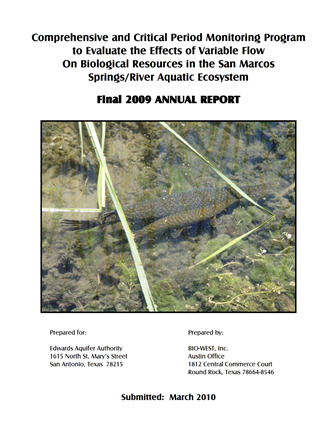Comprehensive and Critical Period Monitoring Program to Evaluate the Effects of Variable Flow on Biological Resources in the San Marcos Springs/River Aquatic Ecosystem Final 2009 Annual Report

| Summary |
|
The purpose of this report is to document the results of all aquatic ecosystem monitoring conducted in 2009 at San Marcos Springs located in San Marcos, Texas. The monitoring and report preparation was performed by BIO-WEST, Inc. Pflugerville, Texas. [Excerpted from Executive Summary] Discharge in the San Marcos River in 2009 decreased to levels not observed since this study began in 2000. Springflow was under 100 cubic feet per second (cfs) for 243 days (157 consecutively), with a minimum flow of 83 cfs in June, which was the lowest minimum flow in the river since 1996 (76 cfs). Springflow remained below 120 cfs for three quarters of the year (275 days). Mean monthly flows were below historic average flows for 18 straight months (dating back to March 2008). A myriad of effects were observed as a result of these low flows including elevated water temperatures, changes in aquatic vegetation coverage, and changes in channel morphology. Conditions experienced in 2009 allowed a comprehensive evaluation of the biota over an extended period of time with lower than average flows in the system…. [W]ater chemistry (conductivity, pH, dissolved oxygen, etc.) were similar to the previous Critical Period low-flow event in 2006. Water temperatures exceeded 26.67 ºC (water quality standard set forth by the Texas Commission on Environmental Quality [TCEQ]) at three sites in 2009…. Low flows coupled with recreation pressure in summer resulted in the least amount of aquatic vegetation coverage in the City Park Reach since the study’s inception…. Texas wild-rice (Zizania texana) coverage experienced similar declines in 2009, with decreases a result of both lower than average flows and recreational pressure. Overall, the total amount of Texas wild-rice decreased by 14% from summer 2008 to fall 2009. This was the lowest total amount since the Critical Period low-flow event in 2006. However, since this program first started measuring the total amount of Texas wild-rice in the river in 2001, it has shown a steadily increasing trend (with occasional decreases). The highest recorded total area of Texas wild-rice measured in the San Marcos River since the inception of the study occurred in January 2009. This year (2009) was the first year in which coverage of Texas wild-rice was quantified in winter (January), when recreation pressure is at its lowest. As the lower than-average flows of 2009 continued and winter gave way to summer, the total area of Texas wild-rice began to decrease…. Changes in aquatic vegetation observed in 2009 influenced fountain darter (Etheostoma fonticola) habitat, and thus, population estimates. As stated earlier, by fall 2009 the middle portion of the City Park Reach had become shallower and much of the Hydrilla and Potamogeton that occupied this area had been uprooted. Since fountain darter population estimates are based on vegetation coverage, the population estimate of fountain darters in this reach declined. In fact, fall 2009 exhibited the lowest overall population estimate of the study period (2000 – 2009). However, it is important to note that this is based solely on changes in vegetation coverage. When fountain darter density is analyzed by sample event, the overall density for City Park Reach in fall 2009 (8.6/m2) is considerably higher than the long-term average for this reach (4.4/m2)…. Additional analysis was conducted in 2009 to further explore the relationship between fountain darter abundance/density and discharge. When analyzed over the entire study period, total abundance and overall density show a negative relationship with discharge. That is, as discharge increases, abundance and density of darters decreases. This may be related to darters becoming concentrated into more limited habitat under lower flow conditions or decreased sampling efficiency under high flows. San Marcos Salamander (Eurycea nana) populations did not appear to be affected by the lower than average flows in the San Marcos River in 2009…. The recent drought in Central Texas provided a unique opportunity to observe the biota in the San Marcos River over an extended period of lower than average flows. Multiple sampling efforts in 2009 provided valuable data on the effects of these flows combined with increased summer recreational pressure. Immediate effects of this pressure were apparent for Texas wild-rice and other aquatic vegetation types, and thus also influenced important fountain darter habitat. However, other study components such as San Marcos salamanders did not appear to be directly affected. Initial conditions and their effects are similar to those observed in 2006 when discharge was also below average. |
Search for Documents
Advance Search
Explore EAA's Scientific Reports
- All Reports
- Surface Water / Groundwater Relationship
- Biology
- Springs, Groundwater Discharge
- Archaeology
- RZ Protection
- Aquifer Levels
- Remote Sensing
- Precipitation
- Overview Studies
- Modeling
- Hydrology and Hydrogeology
- History
- Groundwater Recharge, Recharge Zone
- Groundwater Movement
- Geomorphology and Caves
- Weather Modification
- Geology
- Water Use and Conservation
- Geochemistry
- Water Resources Planning and Management
- Floods and Drought
- Water Quality
- Climatology
